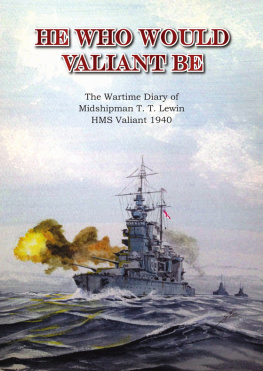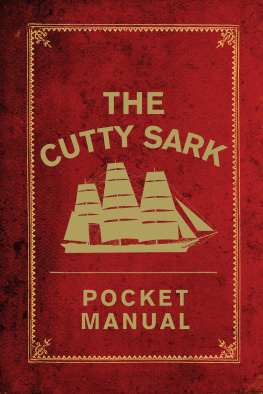DEDICATION
This book is dedicated to the enduring memory of Terry Lewin
Admiral of the Fleet Lord Lewin of Greenwich KG GCB LVO DSC

WITH SPECIAL THANKS
The National Maritime Museum, Greenwich, curators of the Lewin Collection including the originals of these journals.
Jim Bryce, who transcribed the Journals from manuscript, former RN P.O. weapons technician, HMS Ark Royal, HMS Undaunted, HMS Exmouth and HMS Collingwood.
Jim Rae, who painted the cover illustrations, former RN aircraft branch, HMS Eagle, HMS Victorious, HMS Ark Royal, acclaimed marine artist and civil engineer.
Vice-Admiral Roderick Douglas Roddy Macdonald, lifelong family friend.
Phil Reed OBE, director, HMS Belfast & The Cabinet War Rooms, IWM
Richard Hill who wrote the masterly biography.
The Greenwich Foundation.
The www.naval-history.net for the chronology box pieces at the beginning of each month in the Journal.
And to all those whose photos I might have inadvertently used without permission.
Simon Page of Impact Printing, Hastings, for setting up the book and printing.
Contents
FOREWORD

It is curious that, in such a big organisation as the Royal Navy was during World War II, and with regular changes of appointments, it so happened that you came across some officers more frequently than others. I left Dartmouth in late 1939 and joined my first ship, HMS Ramillies, in Colombo at the end of the year. I discovered that we were on our way to Australia to escort the Australian Expeditionary Force to Egypt. It so happens that I was still a Greek citizen at the time we arrived in the Red Sea, and Greece had not yet been invaded by Italy, so I was technically a non-combatant. I was therefore transferred first to the cruiser, HMS Kent and then to HMS Shropshire, both serving on the East Indies Station and based in Colombo. Italy invaded Greece in June 1940, so I became a combatant. It was then that I was appointed to HMS Valiant in the Mediterranean Fleet based in Alexandria. Terry Lewin was the Senior Midshipman in the Gunroom. The next time we served together was after the war, in 1949, when I was appointed as First Lieutenant of HMS Chequers, the Flotilla Leader of the 1st Destroyer Flotilla based in Malta. Terry Lewin was the Flotilla Gunnery officer.
The next time we came across each other was when he was appointed as Commander of the Royal Yacht Britannia in 1957. From there Lewins career took off and we came across each other from time to time as he climbed the ladder. In 1948 I was appointed a Trustee of the National Maritime Museum in Greenwich, and then, several years later, to my great delight, Lewin joined the Trustees, and eventually became its very effective Chairman.
When his son, Tim, told me that he was intending to publish Terrys Midshipmans Log, and asked me to write a short Foreword, I was only too delighted to accept the invitation. Terry was a great friend and a wonderful colleague, who reached the pinnacle of his Service and went on to be Chief of the Defence Staff. He brought all his gifts of clear sight, imagination and even temper to the management of the Museum at a particularly critical period of its development. It was a pleasure and a great satisfaction to have known and worked with him over all those years.

INTRODUCTION
Every so often a family produces a quite exceptional personality. Terry Lewin was born into an ordinary family on 19th November 1920, and from a very early stage he displayed all the qualities of a man destined for the very peak of his profession.
Although he was born in Dover, the Lewin family soon moved to Tonbridge in Kent where Terry Lewin was sent to study at the Judd School. Eric Lewin, Terrys father, had served in the Kentish Yeomanry throughout the First World War and been lucky enough to survive the entire duration of the conflict. Through his friendship with fellow veteran, the headmaster of the Judd school, Eric Lewin was able to enrol both of his sons, Terry and Alexander. Terry, the younger of the two, rapidly rose through the school to become head boy and dominate the track and field events in school athletics. On leaving school he was selected by the Public Schools Exploring Society to take part in an adventure expedition to Newfoundland in 1938. The expedition was managed on the ground by former Royal Navy Petty officers, the young Lewin was immediately impressed by the skill and command with which these old salts organised their charges, although he considered most of the others on the mission to be as wet as scrubbers!
On returning to the UK Terry Lewin initially considered joining the Police Force, but with war clearly imminent and the fact that the police college had an entry age limit of 19, he determined after a short discussion with his father to apply to the Royal Navy.
The Royal Navy had not long before accelerated its Special Entry programme for enrolling new officers. Introduced in 1913 the Special Entry category had not been strongly promoted by the RN; Until the mid-1930s as the approach of war became more ominous the Royal Navy had grown-its-own officers at the Britannia Royal Naval College in Dartmouth where the enrolment age was 13. Realising, as the prospect of another war became more and more apparent, that there would not be enough officers to man the rapidly growing Navy, enthusiasm for the special category was aggressively ramped up. This encouraged school leavers with the right certificates to apply to join the Navy at the age of 18. Terry Lewin applied under this scheme and was accepted in October 1938, he very quickly found himself on an accelerated track towards commissioning. As a cadet he joined first of all the training cruiser HMS Frobisher and then HMS vindictive where a high-pressure regime of boat-work and basic seamanship was the daily routine. Frobisher was based in Portsmouth harbour but the transfer to Vindictive, a seagoing ship, changed life for the cadets who spend most of their time at sea in rigorous conditions hoisting in not just the contents of the Manual of Seamanship but also the responsibilities, duties and skills of a trainee officer of the Royal Navy. It was during this time that Terry Lewin, an enthusiastic rugby player who had captained the Judd school side, met and befriended fellow cadet Roddy Macdonald, another keen rugby player who had captained the Scottish schools side. Linked by their adjacent initials and enthusiasm for rugby football, not to mention the life afloat, Lewin and Macdonald established a friendship that was to last the rest of their lifetimes.
After only 11 months Lewin and Macdonald qualified as Midshipman in His Majestys Royal Navy. Within days the pair were posted to join the brand new cruiser HMS Belfast lying at Scapa Flow, the home Fleet base in the Orkneys. HMS Belfast had only been in commission herself a matter of weeks when the pair joined her.


![Lewin - The other Ultra : [codes, ciphers and the defeat of Japan]](/uploads/posts/book/93695/thumbs/lewin-the-other-ultra-codes-ciphers-and-the.jpg)














